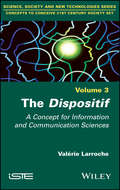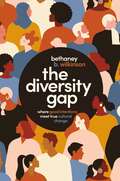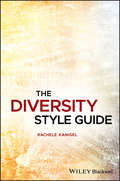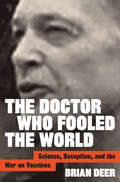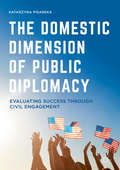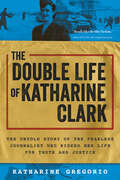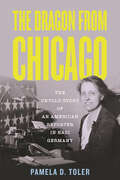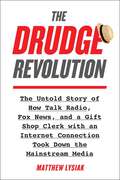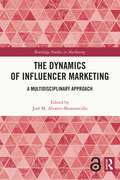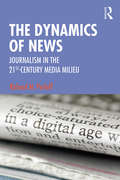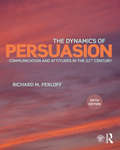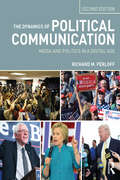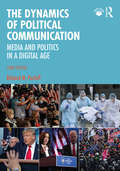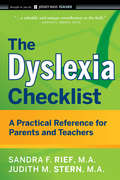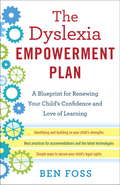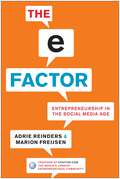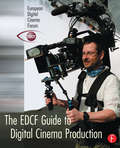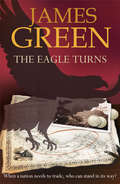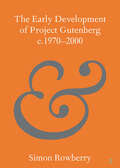- Table View
- List View
The Dispositif: A Concept for Information and Communication Sciences
by Valerie LarrocheThe notion of the dispositif (dispositive) is particularly relevant for understanding phenomena where one can observe the reproducibility of distributed technical activities, operational or discursive, between human and non-human actors. This book reviews the concept of the dispositive through various disciplinary perspectives, analyzing in turn its technical, organizational and discursive dimensions. The relations of power and visibility enrich these discussions. Regarding information and communication sciences, three main uses of this concept are presented, on the one hand to illustrate the heuristic scope of issues integrating the dispositive and, on the other hand, to demonstrate its unifying aspect in this disciplinary field. The first use concerns the complexity of media content production; the second relates to activity traces using the concept of the “secondary information dispositive”; finally, the third involves the use of the dispositive in contexts of digital participation.
The Disputed Freedoms of a Disrupted Press (Disruptions)
by Ivor ShapiroThe Disputed Freedoms of a Disrupted Press explores the origins, connections, and contradictions evident amongst divergent understandings of press freedom around the world. Drawing on examples from various countries and cultures, this book distinguishes the universal right of free expression from the more complex and innately conditional liberties claimed by news media. It examines journalists’ common goals and norms in light of polarized and disordered information channels, reckonings with identity and privilege, diminished public trust, and altered revenue streams. The author discusses emerging forms of accurate, contextualized news production and argues that journalistic autonomy can be sustained only through demonstrated accountability for providing factual information about public affairs according to self-regulated professional standards. The book concludes by proposing a principle-based framework for enhancing the case for press protections and opposing disinformation while minimizing harm. Adopting this approach would require many publishers and editors to consider paradigm shifts and structural changes. This is a timely contribution to the body of literature on press freedom and will be a valued resource for advanced students and researchers seeking a contemporary understanding of journalistic practice and the evolving foundations of media law.
The Distance Cure: A History of Teletherapy
by Hannah ZeavinPsychotherapy across distance and time, from Freud&’s treatments by mail to crisis hotlines, radio call-ins, chatbots, and Zoom sessions.Therapy has long understood itself as taking place in a room, with two (or more) people engaged in person-to-person conversation. And yet, starting with Freud&’s treatments by mail, psychotherapy has operated through multiple communication technologies and media. These have included advice columns, radio broadcasts, crisis hotlines, video, personal computers, and mobile phones; the therapists (broadly defined) can be professional or untrained, strangers or chatbots. In The Distance Cure, Hannah Zeavin proposes a reconfiguration of the traditional therapeutic dyad of therapist and patient as a triad: therapist, patient, and communication technology. Zeavin tracks the history of teletherapy (understood as a therapeutic interaction over distance) and its metamorphosis from a model of cure to one of contingent help. She describes its initial use in ongoing care, its role in crisis intervention and symptom management, and our pandemic-mandated reliance on regular Zoom sessions. Her account of the &“distanced intimacy&” of the therapeutic relationship offers a powerful rejoinder to the notion that contact across distance (or screens) is always less useful, or useless, to the person seeking therapeutic treatment or connection. At the same time, these modes of care can quickly become a backdoor for surveillance and disrupt ethical standards important to the therapeutic relationship. The history of the conventional therapeutic scenario cannot be told in isolation from its shadow form, teletherapy. Therapy, Zeavin tells us, was never just a &“talking cure&”; it has always been a communication cure.
The Diversity Gap: Where Good Intentions Meet True Cultural Change
by Bethaney WilkinsonA sweeping leadership framework to institute clear and intentional actions throughout your organization so that people of all racial backgrounds are empowered to lead, collaborate, and excel at work.The Diversity Gap is a fearless, groundbreaking guide to help leaders at every level shatter the barriers that are causing diversity efforts to fail.Combining real-world research with honest first-person experiences, racial justice facilitator Bethaney Wilkinson provides leaders a replicable structure to foster a diverse culture of belonging within your organization.With illuminating and challenging insights on every page, you will:Better understand today&’s racial climate and its negative impact on your organization and team;Be equipped to shift your organizational culture from one that has good intentions for &“diversity&” to one that addresses systemic barriers to all employees thriving at work; andBe emboldened to participate in creating an organizational culture where people from various racial backgrounds are growing in their purpose, making their highest contributions, and collaborating effectively towards greater impact at work and in the world.Ultimately, The Diversity Gap is the quantum shift between well-intentioned organizational diversity programs that do little to move the needle and a lasting culture of equity and belonging that can transform your organization and outpace your industry.
The Diversity Style Guide: A Journalist's Handbook
by Rachele KanigelA companion to the online resource of the same name, The Diversity Style Guide raises the consciousness of journalists who strive to be accurate. Based on studies, news reports and style guides, as well as interviews with more than 50 journalists and experts, it offers the best, most up-to-date advice on writing about underrepresented and often misrepresented groups. Addressing such thorny questions as whether the words Black and White should be capitalized when referring to race and which pronouns to use for people who don’t identify as male or female, the book helps readers navigate the minefield of names, terms, labels and colloquialisms that come with living in a diverse society. <p><p> The Diversity Style Guide comes in two parts. Part One offers enlightening chapters on Why is Diversity So Important; Implicit Bias; Black Americans; Native People; Hispanics and Latinos; Asian Americans and Pacific Islanders; Arab Americans and Muslim Americans; Immigrants and Immigration; Gender Identity and Sexual Orientation; People with Disabilities; Gender Equality in the News Media; Mental Illness, Substance Abuse and Suicide; and Diversity and Inclusion in a Changing Industry. Part Two includes Diversity and Inclusion Activities and an A-Z Guide with more than 500 terms. <p> The Diversity Style Guide is first and foremost a guide for journalists, but it is also an important resource for journalism and writing instructors, as well as other media professionals. In addition, it will appeal to those in other fields looking to make informed choices in their word usage and their personal interactions.
The Diving Bell and the Butterfly: A Memoir of Life in Death
by Jean-Dominique Bauby Jeremy LeggattIn December 1995, Jean-Dominique Bauby, the forty-three-year-old editor of French Elle, suffered a massive stroke that left him completely and permanently paralyzed, a victim of "locked-in syndrome." Where once he had been renowned for his gregariousness and wit, Bauby now found himself imprisoned in an inert body, able to communicate only by blinking his left eye. The miracle is that in doing so he was able to compose this stunningly eloquent memoir, which was published two days before Bauby's death in 1996 and went on to become a number-one bestseller across Europe. The second miracle is that is less a record of affliction than it is a celebration of the liberating power of consciousness. In a voice that is by turns wistful and mischievous, angry and sardonic, Bauby tells us what it is like to spend a day with his children; to imagine lying in bed beside his lover; to conjure up the flavor of delectable meals even as he is fed by tube. Most of all, this triumphant book allows us to follow the flight of an indomitable spirit and to share its exultation at its own survival. (Taken from the back cover)
The Doctor Who Fooled the World: Science, Deception, and the War on Vaccines
by Brian DeerFrom San Francisco to Shanghai, from Vancouver to Venice, controversy over vaccines is erupting around the globe. Fear is spreading. Banished diseases have returned. And a militant "anti-vax" movement has surfaced to campaign against children's shots.But why?In The Doctor Who Fooled the World, award-winning investigative reporter Brian Deer exposes the truth behind the crisis. Writing with the page-turning tension of a detective story, he unmasks the players and unearths the facts. Where it began. Who was responsible. How they pulled it off. Who paid.At the heart of this dark narrative is the rise of the so-called "father of the anti-vaccine movement": a British-born doctor, Andrew Wakefield. Banned from medicine, thanks to Deer's discoveries, he fled to the United States to pursue his ambitions, and now claims to be winning a "war."In an epic investigation spread across fifteen years, Deer battles medical secrecy and insider cover-ups, smear campaigns and gagging lawsuits, to uncover rigged research and moneymaking schemes, the heartbreaking plight of families struggling with disability, and the scientific scandal of our time.
The Domestic Dimension of Public Diplomacy
by Katarzyna PisarskaThis book explores new grounds that public diplomacy is entering today, as domestic publics come to the forefront of the policy - acting both as foreign policy constituencies and public diplomacy actors cooperating with their foreign counterparts. The author discusses the phenomena of public diplomacy's domestic dimension described as government's ability to engage its own society in foreign policy practices through information, cooperation and identity-defining. By analysing data from over 80 recorded interviews with Australian, Norwegian and American public diplomacy practitioners, this volume illustrates both successful and unsuccessful models of such cooperation. From Norwegian Peace Diplomacy, through Australia's ambivalent engagement with Asia, to U. S. Government-sponsored exchange programs, the author argues that governments around the world are slowly accepting a paradigm shift in diplomatic practice from monological/dialogical to a more collaborative public diplomacy. This book is an essential resource for students, scholars, experts and diplomats interested in world's best-practices of engaging domestic civil society actors in foreign policy statecraft.
The Double Life of Katharine Clark: The Untold Story of the Fearless Journalist Who Risked Her Life for Truth and Justice
by Katharine Gregorio"Gregorio tells [Katharine] Clark's story in engaging, well-researched and vivid detail...an eloquent tribute." —Wall Street JournalIf you loved Kate Moore's The Radium Girls, Sonia Purnell's A Woman of No Importance, or Rebecca Donner's All the Frequent Troubles of Our Days, you'll be enthralled with this untold true story of how Katharine Clark, a trailblazing journalist, exposed the truth about Communism to the world.In 1955, Katharine Clark, the first American woman wire reporter behind the Iron Curtain, saw something none of her male colleagues did. What followed became one of the most unusual adventure stories of the Cold War. While on assignment in Belgrade, Yugoslavia, Clark befriended a man who, by many definitions, was her enemy. But she saw something in Milovan Djilas, a high-ranking Communist leader who dared to question the ideology he helped establish, that made her want to work with him. It became the assignment of her life.Against the backdrop of protests in Poland and a revolution in Hungary, she risked her life to ensure Djilas's work made it past the watchful eye of the Yugoslavian secret police to the West. She single-handedly was responsible for smuggling his scathing anti-Communism manifesto, The New Class, out of Yugoslavia and into the hands of American publishers. The New Class would go on to sell three million copies worldwide, become a New York Times bestseller, be translated into over 60 languages, and be used by the CIA in its covert book program.Meticulously researched and written by Clark's great-niece, Katharine Gregorio, The Double Life of Katharine Clark illuminates a largely untold chapter of the twentieth century. It shows how a strong-willed, fiercely independent woman with an ardent commitment to truth, justice and freedom put her life on the line to share ideas with the world, ultimately transforming both herself—and history—in the process.Praise for The Double Life of Katharine Clark:"Reads like thriller fiction."—Major General Mari K. Eder, author of The Girls Who Stepped Out of Line"[A] nail-biting story…recreates a forgotten chapter of the Cold War."—Robert D. Kaplan, national bestselling author of Balkan Ghosts"An interesting read well told."—Nina Willner, author of Forty Autumns"[A] fascinating book about an extraordinary woman who made her mark during the Cold War."—Dr. Aleksa Djilas, author of The Contested Country and the son of Steffie and Milovan Djilas
The Dragon Drawing War: Targeting r Blends (Speech Bubbles 2)
by Melissa PalmerThis is a tale of two brothers, duelling to become a dragon drawing champion. Great skill and imagination must be used to become the victor! If you don’t succeed today, do not fear. There will be another war to fight tomorrow. This picture book targets /r/ blends and is part of Speech Bubbles 2, a series of picture books that target specific speech sounds within the story. The series can be used for children receiving speech therapy, for children who have a speech sound delay/disorder, or simply as an activity for children’s speech sound development and/or phonological awareness. They are ideal for use by parents, teachers or caregivers. Bright pictures and a fun story create an engaging activity perfect for sound awareness. Picture books are sold individually, or in a pack. There are currently two packs available – Speech Bubbles 1 and Speech Bubbles 2. Please see further titles in the series for stories targeting other speech sounds.
The Dragon from Chicago: The Untold Story of an American Reporter in Nazi Germany
by Pamela D. TolerFor fans of unheralded women&’s stories, a captivating look at Sigrid Schultz—one of the earliest reporters to warn Americans of the rising threat of the Nazi regime &“No other American correspondent in Berlin knew so much of what was going on behind the scene as did Sigrid Schultz.&” — William L. Shirer, author of The Rise and Fall of the Third ReichWe are facing an alarming upsurge in the spread of misinformation and attempts by powerful figures to discredit facts so they can seize control of narratives. These are threats American journalist Sigrid Schultz knew all too well. The Chicago Tribune's Berlin bureau chief and primary foreign correspondent for Central Europe from 1925 to January 1941, Schultz witnessed Hitler&’s rise to power and was one of the first reporters—male or female—to warn American readers of the growing dangers of Nazism.In The Dragon From Chicago, Pamela D. Toler draws on extensive archival research to unearth the largely forgotten story of Schultz&’s years spent courageously reporting the news from Berlin, from the revolts of 1919 through the Nazi rise to power and Allied air raids over Berlin in 1941. At a time when women reporters rarely wrote front-page stories and her male colleagues saw a powerful unmarried woman as a &“freak,&” Schultz pulled back the curtain on how the Nazis misreported the news to their own people, and how they attempted to control the foreign press through bribery and threats.Sharp and enlightening, Schultz's story provides a powerful example for how we can reclaim truth in an era marked by the spread of disinformation and claims of &“fake news.&”
The Drudge Revolution: The Untold Story of How Talk Radio, Fox News, and a Gift Shop Clerk with an Internet Connection Took Down the Mainstream Media
by Matthew LysiakMatt Drudge has been labeled everything from "the Walter Cronkite of his era" to a "dangerous menace" and the "country's reigning mischief-maker." Political tastes aside, no one disputes Drudge's influence: a single link from his website, The Drudge Report, has the power to move news cycles, shape front pages, and send television producers into a desperate scramble. The internet blogger equipped with no more than a high school education has been credited for everything from the impeachment of President Bill Clinton to the death of print news and the election of President Donald Trump. Carl Bernstein went so far as to call Drudge an "influence unequaled" in American politics. But nearly 20 years after first bursting into the mainstream of American consciousness with his groundbreaking role in the investigation of President Clinton, remarkably little remains known about the man behind the keyboard or the improbable rise that ushered in a new era of media. In The Drudge Revolution, investigative journalist and author of Newtown: An American Tragedy Matthew Lysiak pulls back the curtain on the world's most powerful journalist, for the first time telling the inside story of how one man's visionary belief in the potential of the internet, coupled with the post–Fairness Doctrine growth of conservative talk radio and the rise of cable news and social media, created the perfect storm that seized the narrative from the mainstream media and ushered in the presidency of Donald Trump. Never-before-seen details include: Newly uncovered information about Matt's early life, including exclusive interviews with his friends. Exclusive interviews with Joseph Curl, longtime friend and editor of the Drudge Report, who breaks his silence for the first time. Revealing details about Drudge's relationship with Andrew Breitbart, the creation of Breitbart.com, and a "pay-to-play" scheme employed by both the Drudge Report and Breitbart. Emails from Matt to the Trump campaign, showing his close working hand in helping win the campaign of 2016, his role as advisor to the president, his relationship with Jared Kushner, and his role ousting Steve Bannon. Personal information about how much longer Matt will continue at the helm of the world's most powerful web aggregator. Based on extensive research nearly 200 personal interviews, The Drudge Revolution is the definitive portrait of the most powerful man in media, and his outsized impact on our world today.
The Dynamics of Broadband Markets in Europe
by Wolter Lemstra William H. MelodyThe European Commission's Digital Agenda for Europe sets the targets for broadband development by 2020, yet current broadband market outcomes vary widely amongst the EU Member States and the objectives seem challenging for many. In this book, a group of in-country experts follows a framework of qualitative and quantitative analysis to capture patterns, commonalities and differences between 12 different European countries, in terms of infrastructure endowments, institutional arrangements, time of joining the EU, behavior of market actors, personal interventions of regulators, the role of municipalities, and the role perception of governments. By exploring how the past explains present broadband market outcomes, these longitudinal country case studies look to how improvements can be made for the future. As the first in-depth study of broadband developments in Europe, this book will be invaluable to policy-makers, regulators, academic researchers, advisors, and consultants working in the fields of telecommunications, broadband development, technology and innovation.
The Dynamics of Influencer Marketing: A Multidisciplinary Approach (Routledge Studies in Marketing)
by José M. Álvarez-MonzoncilloYouTube, Instagram, Facebook, Vimeo, Twitter, etc. have their own logics, dynamics and different audiences. This book analyses how the users of these social networks, especially those of YouTube and Instagram, become content prescribers, opinion leaders and, by extension, people of influence. What influence capacity do they have? Why are intimate or personal aspects shared with unknown people? Who are the big beneficiaries? How much is vanity and how much altruism? What business is behind these social networks? What dangers do they contain? What volume of business can we estimate they generate? How are they transforming cultural industries? What legislation is applied? How does the legislation affect these communications when they are sponsored? Is the privacy of users violated with the data obtained? Who is the owner of the content? Are they to blame for "fake news"? In this changing, challenging and intriguing environment, The Dynamics of Influencer Marketing discusses all of these questions and more. Considering this complexity from different perspectives: technological, economic, sociological, psychological and legal, the book combines the visions of several experts from the academic world and provides a structured framework with a wide approach to understand the new era of influencing, including the dark sides of it. It will be of direct interest to marketing scholars and researchers while also relevant to many other areas affected by the phenomenon of social media influence.
The Dynamics of News: Journalism in the 21st Century Media Milieu
by Richard PerloffThis new and highly readable textbook by Richard M. Perloff introduces students to the complex world of contemporary news and its theoretical underpinnings, engaging with debates and ethical quandaries. The book takes readers on a concept-guided tour of the contours, continuities, and changing features of news. It covers a huge breadth of topics including: the classic theories of what news should do, its colorful history in America and popular myths of news, the overarching forces involved in contemporary news gathering, critical economic determinants of news and social system influences, and innovative trends in the future of journalism. Drawing on scholarship in the fields of journalism studies and sociology of news, Perloff offers readers a critical, in-depth exploration of news filled with relevant examples from newspapers, newscasts, and social media. Students of journalism, communication, sociology, politics, and related courses, as well as inquisitive scholars, will find this book’s intellectual focus enriching, the writing and examples engaging, and the thoroughness of its search of the contemporary media scene invigorating. Boxes summarizing theory and key concepts help students to deepen their understanding of both what news is now and its future.
The Dynamics of Persuasion: Communication and Attitudes in the Twenty-First Century (Routledge Communication Series)
by Richard M. PerloffThe Dynamics of Persuasion has been a staple resource for teaching persuasion for nearly two decades. Author Richard M. Perloff speaks to students in a style that is engaging and informational, explaining key theories and research as well as providing timely and relevant examples. The companion website includes materials for both students and instructors, expanding the pedagogical utilities and facilitating adoptions. The sixth edition includes: updated theoretical and applied research in a variety of areas, including framing, inoculation, and self-affirmation; new studies of health campaigns; expanded coverage of social media marketing; enhanced discussion of the Elaboration Likelihood Model in light of continued research and new applications to everyday persuasion. The fundamentals of the book – emphasis on theory, clear-cut explanation of findings, in-depth discussion of persuasion processes and effects, and easy-to-follow real-world applications – continue in the sixth edition.
The Dynamics of Political Communication: Media and Politics in a Digital Age
by Richard M. Perloff"The Dynamics of Political Communication blends the drama, excitement, and chaos of politics with the extensive body of social science research that maps in detail the role of the communication media in our political life." --Maxwell McCombs, University of Texas at Austin "The effortlessness and accessibility with which this text walks the reader through theories, current examples and exercises will also make it a very popular textbook for undergraduate courses. I look forward to assigning it in my classes."--Dietram A. Scheufele, University of Wisconsin-Madison "Written in an easily accessible style and filled with timely and interesting examples, this textbook would be a first-rate addition to any introductory course on the topic."--Gadi Wolfsfeld, Author of Making Sense of Media and Politics: Five Principles in Political Communication "...an engaging and timely analysis of the central role of media in American politics. ... The book provides multiple perspectives to stimulate critical thought and reflection."--Ann N. Crigler, University of Southern California "Perloff has offered a systematic overview of the topic that allows us to make sense of the chaotic communication environment we are enveloped within. ... A must-read for anyone looking to introduce themselves to this important research area."--R. Lance Holbert, The Ohio State University What impact do news and political advertising have on us? How do candidates use media to persuade us as voters? Are we informed adequately about political issues? Do 21st-century political communications measure up to democratic ideals? The Dynamics of Political Communication: Media and Politics in a Digital Age explores these issues and guides us through current political communication theories and beliefs. Author Richard M. Perloff details the fluid landscape of political communication and offers us an engaging introduction to the field and a thorough tour of the discipline. He examines essential concepts in this arena, such as agenda-setting, agenda-building, framing, political socialization, and issues of bias that are part of campaign news. Designed to provide an understanding and appreciation of the principles involved in political communication along with methods of research and hypothesis-testing, each chapter includes materials that challenge us by encouraging reflection on controversial matters and providing links to online examples of real-life political communication. The text's companion website provides expanded resources for students as well as materials for instructors to use in the classroom. The Dynamics of Political Communication immerses readers in contemporary events through its coverage of online campaigning, effects of negative advertising, issues of gender bias in campaign politics, and image-management strategies in the 2012 campaign. It will prepare you to survey the current political landscape with a more critical eye, and encourage a greater understanding of the challenges and occurrences presented in this constantly evolving field.
The Dynamics of Political Communication: Media and Politics in a Digital Age
by Richard M. PerloffWhat impact do news and political advertising have on us? How do candidates use media to persuade us as voters? Are we informed adequately about political issues? Do twenty-first-century political communications measure up to democratic ideals? The Dynamics of Political Communication: Media and Politics in a Digital Age, Second Edition explores these issues and guides us through current political communication theories and beliefs by detailing the fluid landscape of political communication and offering us an engaging introduction to the field and a thorough tour of the discipline. Author Richard Perloff examines essential concepts in this arena, such as agenda-setting, agenda-building, framing, political socialization, and issues of bias that are part of campaign news. Designed to provide an understanding and appreciation of the principles involved in political communication along with methods of research and hypothesis-testing, each chapter includes materials that challenge us by encouraging reflection on controversial matters. Inside this Second Edition you’ll find: Expanded discussion of conceptual problems, communication complexities, and key issues in the field. New examples, concepts, and studies reflecting current political communication scholarship. The integration of technology throughout the text, reflecting its pervasive role in the political spectrum. Accompanied by an updated companion website with resources for students and instructors, The Dynamics of Political Communication prepares you to survey the political landscape with a more critical eye, and encourages a greater understanding of the challenges and occurrences presented in this constantly evolving field.
The Dynamics of Political Communication: Media and Politics in a Digital Age
by Richard M. PerloffThe third edition of The Dynamics of Political Communication continues its comprehensive coverage of communication and politics, focusing on problematic issues that bear on the functioning of democracy in an age of partisanship, social media, and political leadership that questions media’s legitimacy. The book covers the intersections between politics and communication, calling on related social science disciplines as well as normative political philosophy. This new edition is thoroughly updated and includes a survey of the contemporary political communication environment, unpacking fake news, presidential communication, hostile media bias, concerns about the waning of democracy, partisan polarization, political advertising and marketing, the relationship between social media and the news media, and the 2020 election, all the while drawing on leading new scholarship in these areas. It's ideally suited for upper-level undergraduate and graduate political communication courses in communication, journalism, and political science programs. This edition again features online resources with links to examples of political communication in action, such as videos, news articles, tweets, and press releases. For instructors, an instructor’s manual, lecture slides, and test questions are also provided. Access the support material at www.routledge.com/9780367279417
The Dyslexia Checklist
by Sandra F. Rief Judith Stern M.A.Essential advice and resources for helping kids with dyslexiaThe Dyslexia Checklist is a valuable guide for parents and teachers that can help them better understand children and teenagers with dyslexia and other reading- and language-based disabilities. The book relays the most current research available and is filled with practical strategies, supports, and interventions. Using these tools teachers and parents can accommodate the needs and strengthen the skills of students with reading and writing disabilities across all age levels. The book is presented in a simple, concise, easy-to-read checklist format and is filled with useful advice and information on a wide range of topics.Explains what we now know about dyslexia from decades of researchContains games to strengthen a child's literacy and language skillsProvides important information for hooking in reluctant and struggling readersOffers suggestions for enhancing skills in vocabulary, comprehension, composition and written expression, spelling, math, and moreThe book also provides information on the educational rights of students with dyslexia.
The Dyslexia Empowerment Plan
by Ben FossFinally, a groundbreaking book that reveals what your dyslexic child is experiencing--and what you can do so that he or she will thrive More than thirty million people in the United States are dyslexic--a brain-based genetic trait, often labeled as a "learning disability" or "learning difference," that makes interpreting text and reading difficult. Yet even though children with dyslexia may have trouble reading, they don't have any problems learning; dyslexia has nothing to do with a lack of intellect. While other books tell you what dyslexia is, this book tells you what to do. Dyslexics' innate skills, which may include verbal, social, spatial, kinesthetic, visual, mathematical, or musical abilities, are their unique key to acquiring knowledge. Figuring out where their individual strengths lie, and then harnessing these skills, offers an entrée into learning and excelling. And by keeping the focus on learning, not on standard reading the same way everyone else does, a child with dyslexia can and will develop the self-confidence to flourish in the classroom and beyond. After years of battling with a school system that did not understand his dyslexia and the shame that accompanied it, renowned activist and entrepreneur Ben Foss is not only open about his dyslexia, he is proud of it. In The Dyslexia Empowerment Plan he shares his personal triumphs and failures so that you can learn from his experiences, and provides a three-step approach for success: * Identify your child's profile: By mapping your child's strengths and weaknesses and assisting her to better understand who she is, you can help your child move away from shame and feelings of inadequacy and move toward creating a powerful program for learning. * Help your child help himself: Coach your child to become his own best advocate by developing resiliency, confidence, and self-awareness, and focusing on achievable goals in areas that matter most to him. * Create community: Dyslexic children are not broken, but too often the system designed to educate them is. Dare to change your school so that your child has the resources to thrive. Understanding your rights and finding allies will make you and your child feel connected and no longer alone. Packed with practical ideas and strategies dyslexic children need for excelling in school and in life, this empowering guide provides the framework for charting a future for your child that is bright with hope and unlimited potential.Advance praise for The Dyslexia Empowerment Plan "I study dyslexia in the lab and am a parent of a wonderful daughter who fits this profile. Ben Foss's book should be considered essential to any collection on the subject. It was extremely useful, especially for a mom. Thank you!"--Maria Luisa Gorno Tempini, M.D., Ph.D., professor of neurology, UCSF, Memory and Aging Center "As someone with a learning profile that made school tough, and as a parent, I know kids need the right support. Ben Foss knows how to get access to education because he's been through it. I was thrilled to read this book. It offers a wise collection of insights that are both practical and touching. Buy it today if you want a get a plan for your child."--James Gandolfini, actor, The Sopranos
The E-Factor: Entrepreneurship in the Social Media Age
by Marion Freijsen Adrie ReindersAs an entrepreneur, you're not afraid to bend the rules and think outside the box. You're not burdened with linear thinking, and thinking differently and trying new approaches enable you to solve problems. As serial entrepreneurs and cofounders of the largest social network for entrepreneurs in the world, EFactor.com, Adrie Reinders and Marion Freijsen know about the challenges facing new entrepreneurs in the current business environment. Their site—with a community of one million-plus and growing rapidly—is a virtual marketplace for entrepreneurs to make business connections, negotiate deals, exchange information, and advertise their products and services. In The E-Factor, Reinders and Freijsen educate entrepreneurs on the pitfalls that take down most entrepreneurs before they get started, such as restricted resources, skills gaps, and financial limitations, and show you how to overcome these obstacles. Discover how best to secure funding for your fledgling startup and how to use new forms of social media work to your advantage. Along the way, read a wide array of case studies of successes and learn lessons from others' failures, including those from small business owners and burgeoning entrepreneurs, all the way up to multinational corporations, global brand leaders, and the founders themselves. The E-Factor shows you how to gain leverage and evaluate and reassess goals, products, and company structure to meet needs in a competitive environment. Combine the best traditional entrepreneurial thinking with new tools, ideas, and channels now at your disposal.
The EDCF Guide to Digital Cinema Production
by Lasse SvanbergA professional introduction to the end-to-end process of digital filmmaking!The EDCF Guide to Digital Cinema Production sheds light on the ongoing and confusing transition from analog to digital technology in film production. In addition to a complete analysis of technical concerns, this text deals with a number of issues where European and Hollywood priorities differ. It adds fuel to the discussion on "Photo-Chemical Fundamentalism" and the future of traditional film-based cinematography.With special emphasis on new HD production techniques for the big cinema screen, this guide is the one and only resource available from a European perspective. The EDCF Guide to Digital Cinema Production provides film professionals and decisions-makers in European cinema with an excellent basis for discussions on how to handle the transition from analog to digital technology. Look no further for:* Several production case studies, among them Ingmar Bergman's last film "Saraband" (2003) and Lars von Trier's "Dogville" (2003).* Surveys of HD Systems & Cameras and "The 37 MFAQ on HD Production."* Expert reports on Audio Recording for HD and the Digital Intermediate Process.* Detailed European initiatives in Digital Cinema.* An up-to-date survey of the problematic standards situation for Digital Cinema.* A comprehensive look at archiving - the "Achilles Heel" of digital production.* The pros and cons of producing feature films digitally - a unique and professional view of "the agony and ecstacy."Editor-in-Chief Lasse Svanberg is a founding member of EDCF. He was DoP on 14 feature films 1966-81, founded TM (Technolgy & Man) Magazine at the Swedish Film Institute in 1968 and was its Chief Editor until 1998 He was elected Fellow of BKSTS 1979, Fellow of SMPTE 1995 and granted Professor's title by the Swedish Government 2002. He is the author of six books on the history and possible future of film, video and television.The European Digital Digital Cinema Forum (EDCF) was constituted in June 2001 as joint Swedish-British-French effort to establish a European forum for discussions, information exchange and industrial activities in the field of Digital Cinema. This project was initiated because digital production, digital distribution and digital exhibition of film is the most radical technical change facing the film industry since sound film was introduced.
The Eagle Turns: Agents of Independence Series (Agents Of Independence Ser. #3)
by James Green1850 and America is violently divided on the issue of slavery. When President Zachary Taylor dies, suddenly and under questionable circumstances, it is left to his Vice President, Millard Fillmore, a weaker man, to find ways to keep the North and the South apart.In New York, child of Irish immigrants, Matthew O’Hanlon is fired from his job as a newsman on the Herald but, surprisingly, finds work as Foreign Correspondent for the Associated Press in Panama City. There he is given accommodation with a Dr Couperin, his wife and beautiful daughter, Edith, but finds himself caught up with the secret agents protecting America’s commercial interests during the struggle for control of Panama’s trade routes and, as it crashes about him, realises that he has been living in a house of cards. Set against the Gold Rush and the opening up of California and the OregonTerritories, when the United States walked a narrow and dangerous line, The Eagle Turns charts the course of history as America’s Secret Services struggle to bring prosperity amid the conflict.
The Early Development of Project Gutenberg c.1970–2000 (Elements in Publishing and Book Culture)
by Simon RowberryProject Gutenberg is lauded as one of the earliest digitisation initiatives, a mythology that Michael Hart, its founder perpetuated through to his death in 2011. In this Element, the author re-examines the extant historical evidence to challenge some of Hart's bolder claims and resituates the significance of Project Gutenberg in relation to broader trends in online document delivery and digitisation in the latter half of the twentieth century, especially in the World Wide Web's first decade (the 1990s). Through this re-appraisal, the author instead suggests that Hart's Project is significant as an example of what Millicent Weber has termed a “digital publishing collective” whereby a group of volunteers engage in producing content and that process is as meaningful as the final product.
